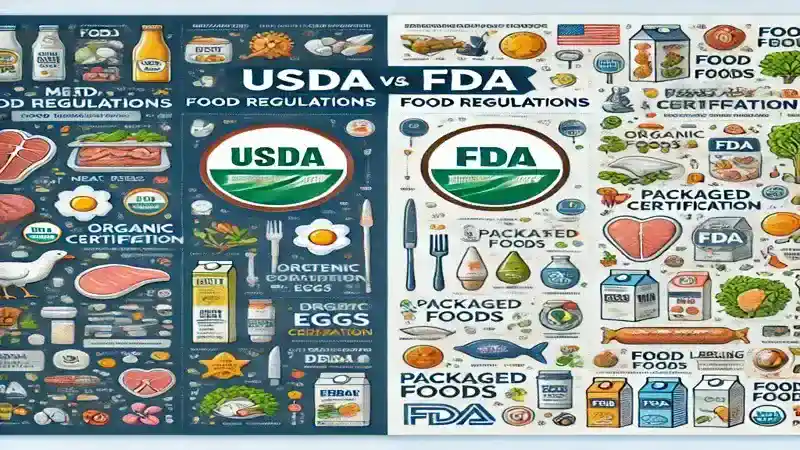
The regulation of food products in the United States is primarily managed by two major federal agencies: the United States Department of Agriculture (USDA) and the Food and Drug Administration (FDA). While both agencies are responsible for food safety, their jurisdictions differ significantly. Understanding these differences is crucial for consumers, food manufacturers, and businesses involved in the food supply chain. This article will compare and contrast what types of food products the USDA and FDA regulate, providing clear examples of each.
Overview of USDA and FDA Regulatory Roles
The USDA and FDA have distinct responsibilities regarding food safety and quality:
- The USDA oversees meat, poultry, and certain egg products, ensuring continuous inspection and quality control.
- The FDA regulates most other food products, including dairy, seafood, packaged foods, fruits, and vegetables.
Each agency operates under different regulatory frameworks, ensuring that food products meet safety standards before reaching consumers. Both agencies work under federal laws such as the Federal Meat Inspection Act (FMIA), the Poultry Products Inspection Act (PPIA), and the Food Safety Modernization Act (FSMA).
USDA: Food Products It Regulates
The USDA’s Food Safety and Inspection Service (FSIS) is responsible for ensuring that meat, poultry, and certain egg products are safe, properly labeled, and correctly packaged. The USDA primarily regulates:
1. Meat Products
- The USDA inspects and regulates beef, pork, lamb, and goat products.
- For example, a pack of ground beef must undergo USDA inspection to ensure it meets safety standards and is free from contaminants.
- Meat must have a USDA inspection seal before being sold.
2. Poultry Products
- The USDA regulates chicken, turkey, duck, and other poultry items.
- Example: A frozen turkey sold in a grocery store must be inspected by the USDA for proper handling and processing.
- Poultry processing plants require continuous USDA inspections.
3. Processed Egg Products
- The USDA regulates processed egg products such as liquid eggs, powdered eggs, and frozen egg mixtures.
- Example: Cartons of liquid egg whites are inspected by the USDA to ensure they are free of contaminants.
- The USDA ensures egg products are pasteurized for safety.
4. Farmed Catfish
- The USDA regulates farmed catfish, unlike other seafood, which falls under FDA jurisdiction.
- Example: A U.S. catfish farm must follow USDA regulations for water quality and feeding practices.
FDA: Food Products It Regulates
The FDA oversees approximately 78% of the U.S. food supply, covering a wide range of food products. The key categories regulated by the FDA include:
1. Dairy Products
- Milk, cheese, yogurt, and butter fall under FDA regulation.
- Example: A gallon of milk must meet FDA safety standards before being sold in stores.
- The FDA ensures pasteurization standards are met for dairy safety.
2. Seafood (Except for Certain Farmed Fish)
- The FDA regulates all seafood, including fish and shellfish, except for farmed catfish (which the USDA oversees).
- Example: A can of tuna is monitored by the FDA for mercury levels and proper labeling.
- The FDA enforces HACCP (Hazard Analysis Critical Control Point) regulations for seafood safety.
3. Fruits and Vegetables
- The FDA ensures the safety of fresh and processed fruits and vegetables.
- Example: A bag of pre-washed spinach is checked for bacterial contamination before reaching stores.
- The FDA monitors pesticide residues under the Food Quality Protection Act.
4. Packaged and Processed Foods
- The FDA regulates cereals, snacks, frozen meals, and canned goods.
- Example: A box of breakfast cereal must meet FDA labeling and safety requirements.
- The FDA ensures compliance with the Nutrition Labeling and Education Act (NLEA).
5. Bottled Water and Beverages
- The FDA ensures the safety and labeling of bottled water and non-alcoholic beverages.
- Example: Bottled spring water must comply with FDA purity standards before distribution.
- Carbonated beverages must meet FDA chemical and labeling regulations.
Shared Jurisdictions: Where USDA and FDA Overlap
Some food products fall under the regulation of both agencies, depending on their composition and processing methods. These include:
1. Eggs
- FDA: Regulates whole eggs sold in their shells.
- USDA: Oversees processed egg products such as liquid or powdered eggs.
- Example: A carton of whole eggs in the grocery store falls under FDA regulation, while a carton of liquid egg whites is under USDA oversight.
2. Meat-Containing Processed Foods
- USDA: Regulates products containing more than 3% raw meat or 2% cooked poultry.
- FDA: Regulates products with lower meat content.
- Example: A frozen beef patty is regulated by the USDA, while a canned beef soup with only 2% beef is under FDA jurisdiction.
3. Catfish
- The USDA inspects and regulates farmed catfish, whereas the FDA regulates other seafood.
Inspection and Enforcement Differences
USDA Inspections
- USDA inspectors are required to be present continuously in meat and poultry processing facilities.
- Products receive a USDA inspection seal before being sold to the public.
- The USDA has authority to shut down facilities that fail safety inspections.
FDA Inspections
- FDA inspections are less frequent and typically conducted periodically.
- The FDA issues recalls and warnings when food safety violations occur.
- The FDA has regulatory power under the Food Safety Modernization Act (FSMA) to prevent foodborne illnesses.
Key Differences Between USDA and FDA Food Regulation
| Feature | USDA | FDA |
|---|---|---|
| Regulates | Meat, poultry, processed eggs, farmed catfish | Dairy, seafood, packaged foods, produce, beverages |
| Inspection Frequency | Continuous in meat/poultry plants | Periodic checks |
| Labeling Requirements | Strict for meat and poultry | Covers nutritional information on packaged foods |
| Example Product | Raw beef steak | Canned vegetables |
| Oversight of Processing Plants | Required in USDA facilities | Conducted as needed |
| Authority | Can shut down plants | Issues recalls and warnings |
Collaboration Between USDA and FDA
To ensure seamless food safety oversight, the USDA and FDA collaborate through formal agreements. These agreements help clarify jurisdictional boundaries and enhance communication between the two agencies. One such agreement includes:
- The 2018 USDA-FDA Memorandum of Understanding, which strengthens coordination regarding biotechnology and food safety.
- The Interagency Food Safety Analytics Collaboration (IFSAC), which analyzes foodborne illness sources.
Conclusion
The USDA and FDA play vital roles in regulating the U.S. food supply. While the USDA primarily focuses on meat, poultry, and processed egg products, the FDA oversees a much broader range of foods, including dairy, seafood, fruits, vegetables, and packaged goods. Understanding the regulatory differences helps consumers make informed choices about food safety and labeling. By working together, these agencies ensure the highest standards for food quality and public health in the United States.
For more update please visit my website:letflix



